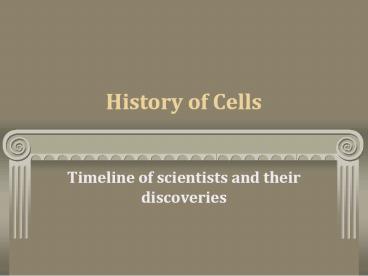History of Cells - PowerPoint PPT Presentation
1 / 16
Title:
History of Cells
Description:
History of Cells Timeline of scientists and their discoveries 1) Anton von Leeuwenhoek 1600 s Dutch businessman Invented 1st simple light microscope Anton von ... – PowerPoint PPT presentation
Number of Views:288
Avg rating:3.0/5.0
Title: History of Cells
1
History of Cells
- Timeline of scientists and their discoveries
2
1) Anton von Leeuwenhoek
- 1600s
- Dutch businessman
- Invented 1st simple light microscope
3
Anton von Leeuwenhoek (cont)
- Observed tiny organisms in pond water
- Organisms were nicknamed wee beasties
4
2) ROBERT HOOKE
- 1665
- English physicist
- Observed flowers, insects, and plant tissue
5
ROBERT HOOKE (cont)
- Observed thin slices of cork (oak tree)
- Coined the term cell based on the rooms in a
monastary
6
3) ROBERT BROWN
- 1833
- Observed plant cells under the microscope
7
ROBERT BROWN (cont)
- Observed a dark structure inside each cell and
coined the term nucleus
8
4) MATTHIAS SCHLEIDEN
- 1838
- German botanist scientist who studies plants
- Concluded all plants are made up of cells
9
5) THEODORE SCHWANN
- 1839
- German biologist
- Concluded all animals are made of cells
10
6) RUDOLF VIRCHOW
- 1855
- German Physician
- Studied cell reproduction
- Concluded all cells arise from preexisting cells
11
The cell theory
- 1. All living things are composed of cells
- 2. Cells are the basic unit of structure and
function in living things. - 3. All cells arise from preexisting cells.
12
Introduction to Cells
- Chapter 6
13
Levels of Organization
- All living organisms can be studied on many
levels - From smallest to largest they are
- Chemical (atoms molecules)
- Cells
- Tissues
- Organs
- Organ Systems
- Whole Organism
14
Basic Structure of Cells
- All cells have a cell membrane and cytoplasm
- Cell Membrane thin, flexible barrier around cell
- Composed of lipids and proteins
- Cytoplasm jelly-like material inside the cell
- All cells contain organelles
- Organelles small structures that perform
different functions within a cell
15
Prokaryotic Cells
- Do NOT have a nucleus
- Instead a small ring of DNA is free-floating in
center of cell - Organelles do NOT have a membrane
- i.e. bacteria (very simple organisms)
16
Eukaryotic Cells
- Contain a nucleus
- Organelles are membrane-bound
- Much more complex
- i.e. plants, animals, fungi































